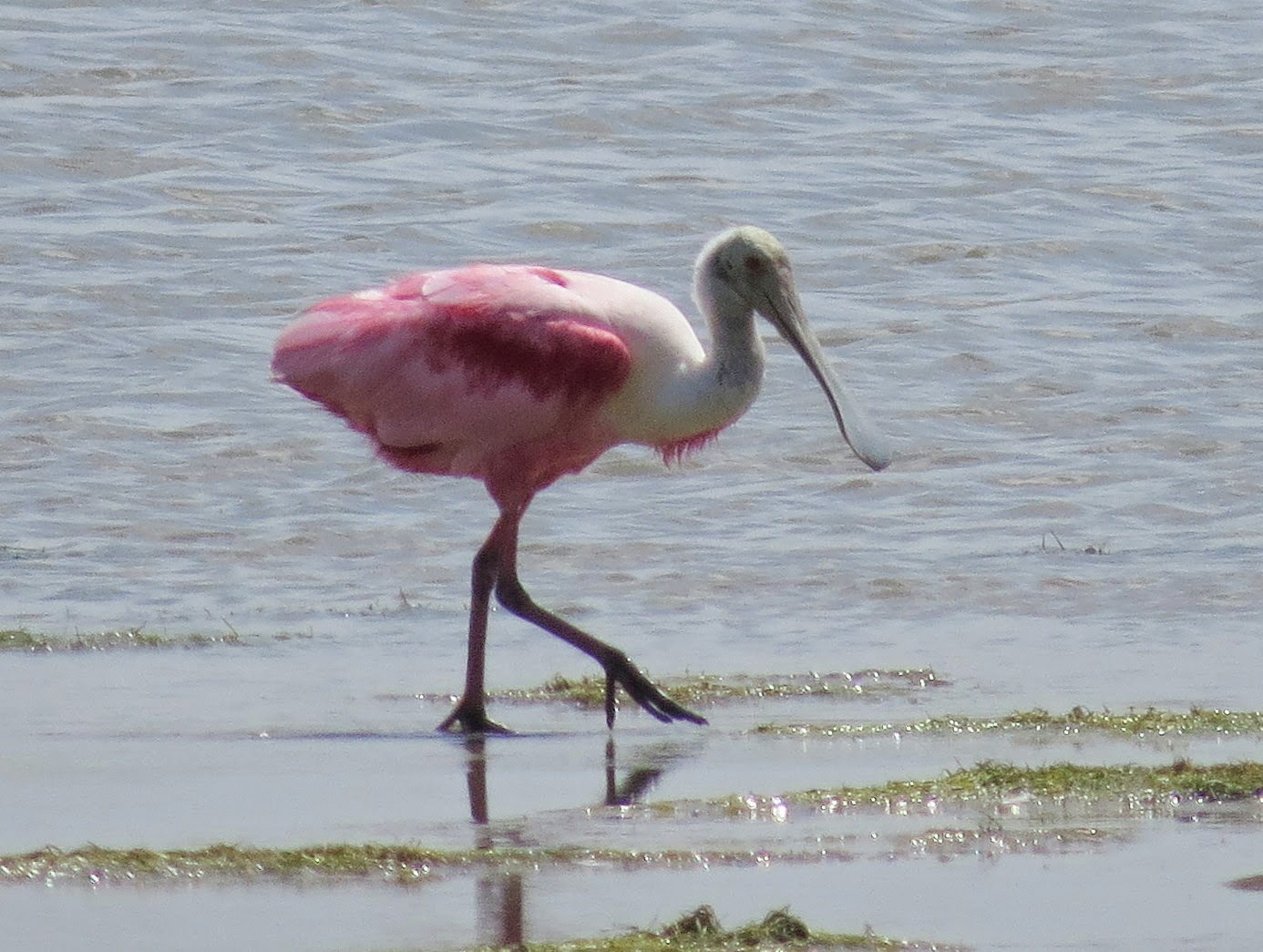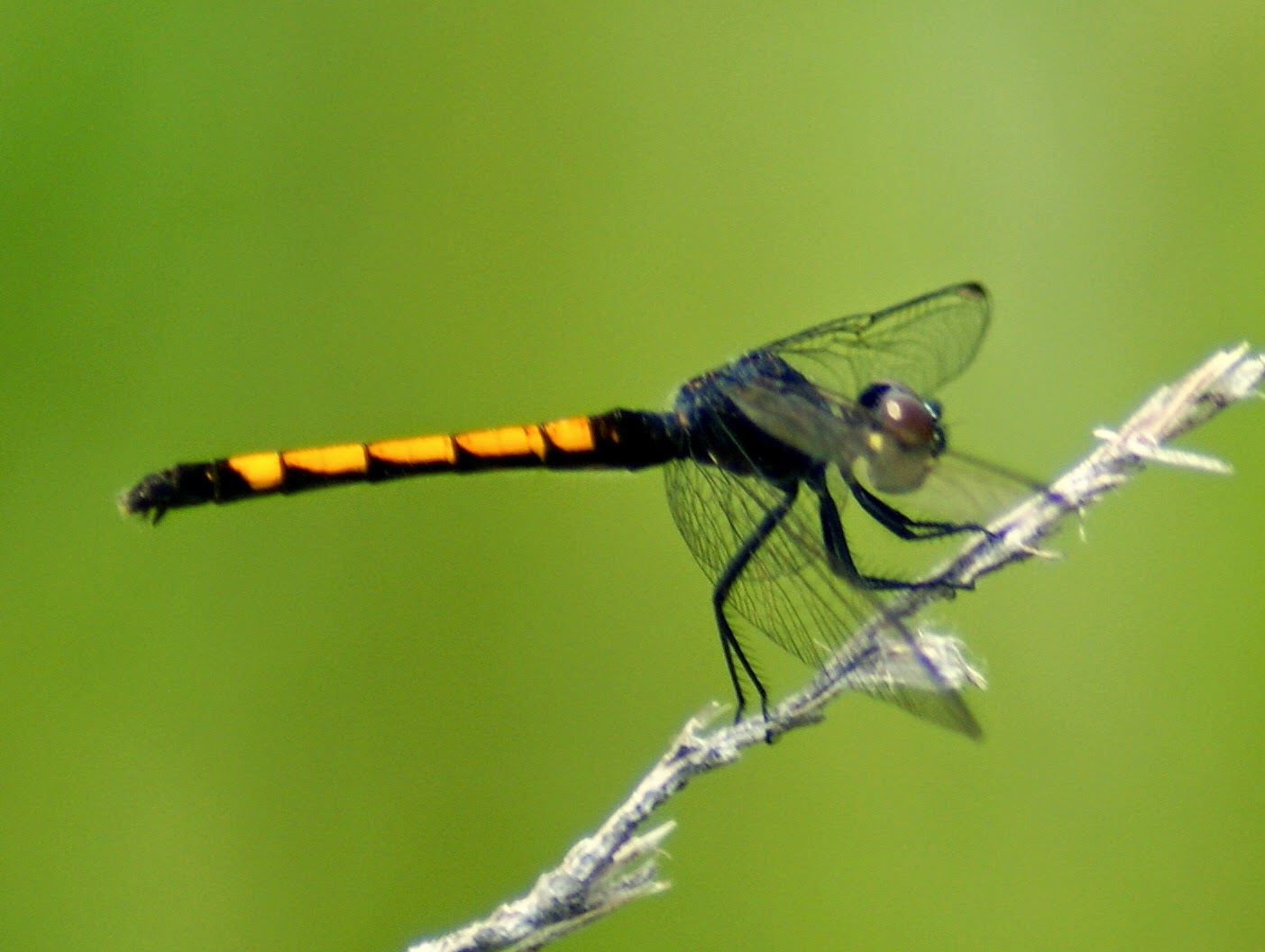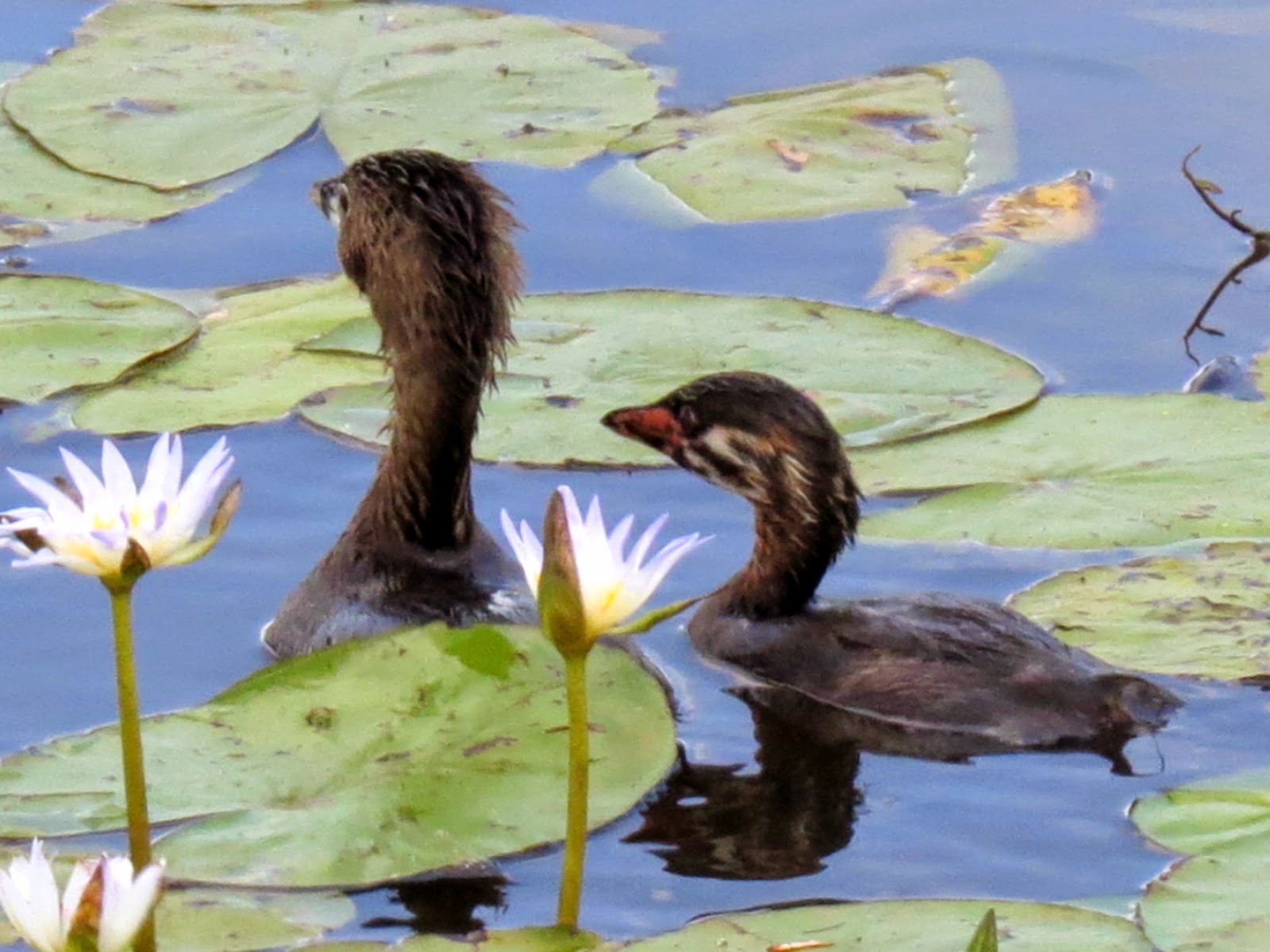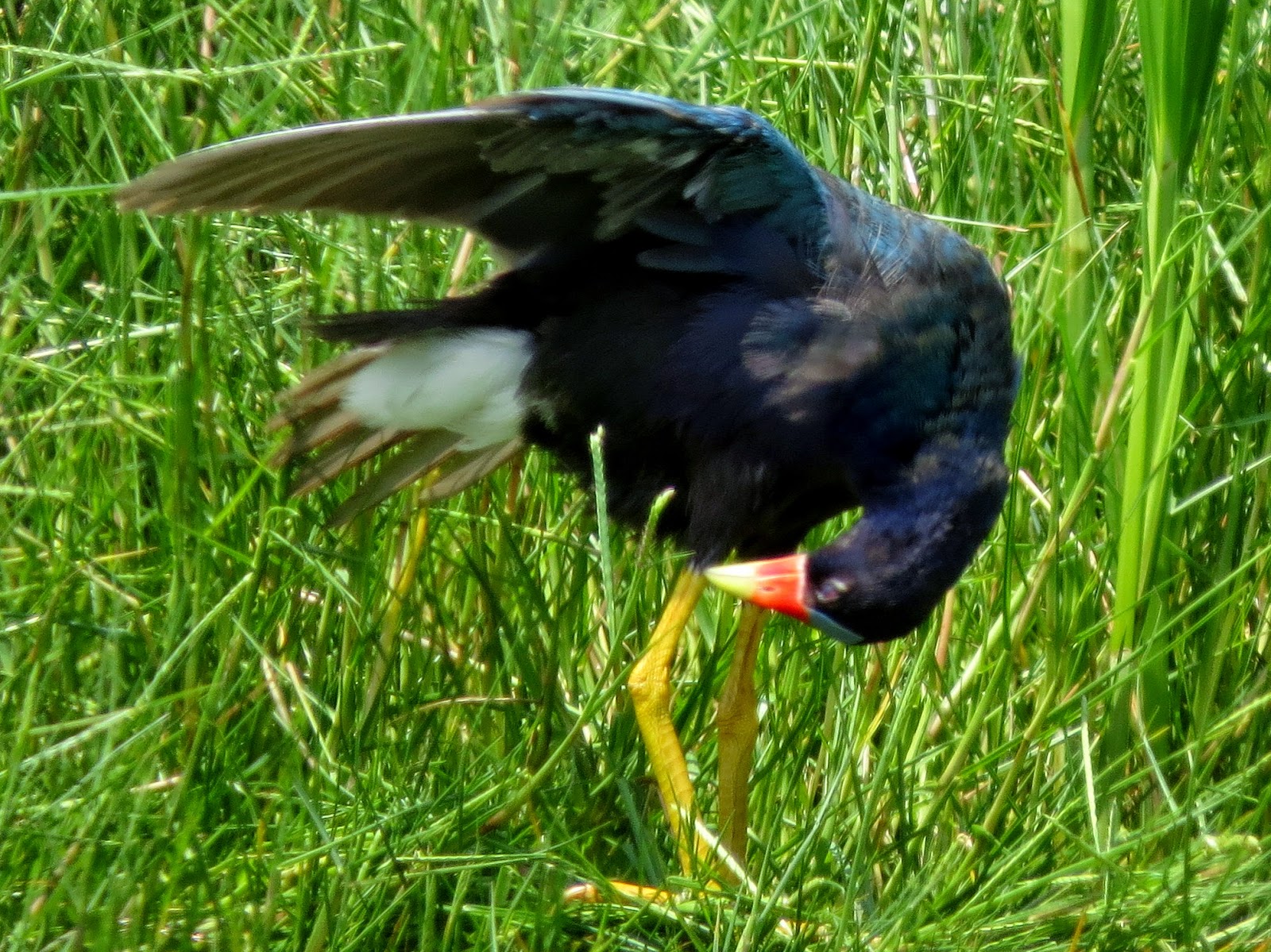.
Late Saturday morning we spent an hour in the park around the San Jacinto Monument.
To be honest, the park isn't one of my favorite birding sites: Although it can host some good birds, the latter are usually too far away for comfortable viewing and photographing. So why did we visit? We were on our way to have lunch at the nearby Monument Inn, and I thought the park might have one of the bird species that has eluded me so far this year: Black-crowned Night-Heron.
We started our visit with a quick walk along the boardwalk, which yielded only very distant views of a few common wading birds, such as Great Egret and Great Blue Heron.
When we drove to the two areas that give views over the bay, we had better luck, although most of the birds were still so distant that photographing them was a challenge.
Several Cattle Egrets in breeding plumage were wandering about on the grass.
A couple of American White Pelicans were cruising the waters while others had settled on islands.
One of two Brown Pelicans was much closer to the shore.
I was delighted to spot two Black-crowned Night-Herons as they flew off when I approached the water. Although I didn't manage to get a photo of them, I did manage to get some shots of seven Wood Storks perched in nearby trees. What extraordinary looking birds they are!
A Tricolored Heron was too intent on fishing to notice our presence.
The size of the prey it caught hardly seemed to justify the effort involved.
A Great Egret was rather more successful.
Further out, Neotropic Cormorants were lined up. These ones were in the company of a Snowy Egret.
A handful of Roseate Spoonbills were grazing in the water.
Other birds, such as a Brown Pelican and a Great Blue Heron, were perched on rocks or pieces of debris that protruded from the water.
So while the park didn't provide great birding, we saw enough to make an hour's visit worthwhile.
.
.
For the past few weeks it has been fun watching a steady stream of Blue Jays coming to our backyard.
They are mainly attracted by the peanuts that we put out on our fence.
While some of these visitors are adults, many of them are juveniles. Very young birds are normally easy to pick out because they don't yet have a full crest and they lack the heavy black band across the top of their chests.
Older juveniles look a little more like adults but their age is given away by the yellow/pink edges of their beaks.
.
.
Between our two loops around Shoveler Pond at Anahuac on Saturday, we drove down to Frozen Point, stopping along the way to check out the roadside ditches and fences.
On our last visit to the refuge we hadn't seen any Common Nighthawks. This time we saw seven. As usual, most were sitting quietly on fence posts.
However, a few were being a little more active.
One was even sitting up, revealing its barred underside.
Halfway down the road, we came upon two King Rails. Although one immediately disappeared, the other crept through the grass on the verge for a couple of minutes while we drove slowly along beside it.
We stopped for a quick picnic lunch at Frozen Point, where we were surrounded by thousands of golden-bodied dragonflies. Neither of us had ever seen so many dragonflies in one place before.
The shoreline was empty of birds except for a solitary Willet.
Willets are very drab birds - until they fly!
I was hoping for Seaside Sparrows and, sure enough, one appeared right where the road is blocked by a gate.
Two other Seaside Sparrows were pottering around in the rocks nearby and then we saw four more as we started our drive back to the Visitor Center. One of them treated us to a beautiful serenade that seemed to last for ages but was probably only 2-3 minutes long.
A few yards up the road we were serenaded by a different bid, this time a Dickcissel. Unfortunately, I wasn't able to get a photo before it flew off. (We had seen several other Dickcissels on the entrance road to the refuge but I hadn't managed to get photos of any of them either.)
At the place where we had seen the King Rails, we stopped again when Dee spotted a bird in a bush. It was our only Least Bittern of the day.
The same area had an adult male Black-necked Stilt.
Further away from the road, another adult Black-necked Stilt was wading in very shallow water. Judging by the brown on this bird's back, it was a female. It was accompanied by what I at first took to be a small shorebird. However, when I looked carefully through binoculars, I realized the small bird was actually a baby Black-necked Stilt.
It was a nice sighting with which to end what had been a very productive and enjoyable visit to our favorite local wildlife site.
.
.
Deanne and I were back at Anahuac National Wildlife Refuge on Saturday morning. It was a beautiful if very hot day and the refuge was looking at its best.
We started and ended our visit with slow drives around Shoveler Pond, where even the alligators seemed to be trying to escape the heat.
The usual Great Blue Herons, Great Egrets and Snowy Egrets were outnumbered by Cattle Egrets. The latter were collecting sticks, presumably for nesting, and they were looking very good in their breeding plumage.
Although we again missed seeing a Black-crowned Night Heron, we did see several Yellow-crowned Night Herons, including this juvenile.
There were also several Green (below), Tricolored (below) and Little Blue Herons.
Eastern Kingbirds and Orchard Orioles were present but absolutely refused to be photographed. Male Red-winged Blackbirds were much less shy.
Way out in the middle of the pond, a dozen or more Roseate Spoonbills were hanging out with as many Wood Storks. As these were out first Wood Storks of 2014, I really wanted to get photos of them. However, they were so far away from the road that my Canon SX50 struggled to produce a picture that was even recognizable.
Luckily, most of the other birds were not so far away.
As on our last trip, Laughing Gulls and Neotropic Cormorants were making good use of roadside signs.
Black-bellied Whistling Ducks were dividing their time between the water and the road itself.
Surprisingly, Fulvous Whistling Ducks outnumbered their Black-bellied cousins on this trip. They looked particularly beautiful as the paddled about among the water-lilies.
Adult and juvenile Pied-billed Grebes were also feeding among the water lilies. The young Grebes have very distinctive face markings.
Everywhere we looked there were Common Gallinules. Some adults and juveniles were foraging or preening on their own.
But most were in family groups.
Equally common but much more difficult to photograph were Purple Gallinules. They would wander along right by the road or even cross it but would disappear into the vegetation as soon as I stopped the car.
Then, just as were were finishing our second tour of the pond, we came across one that was more interested in preening than in our presence.
After our first loop of Shoveler Pond we decided to take the 5-mile drive down to Frozen Point, something we rarely do on our visits to the refuge. As it turned out, this was a very good decision.
.































































